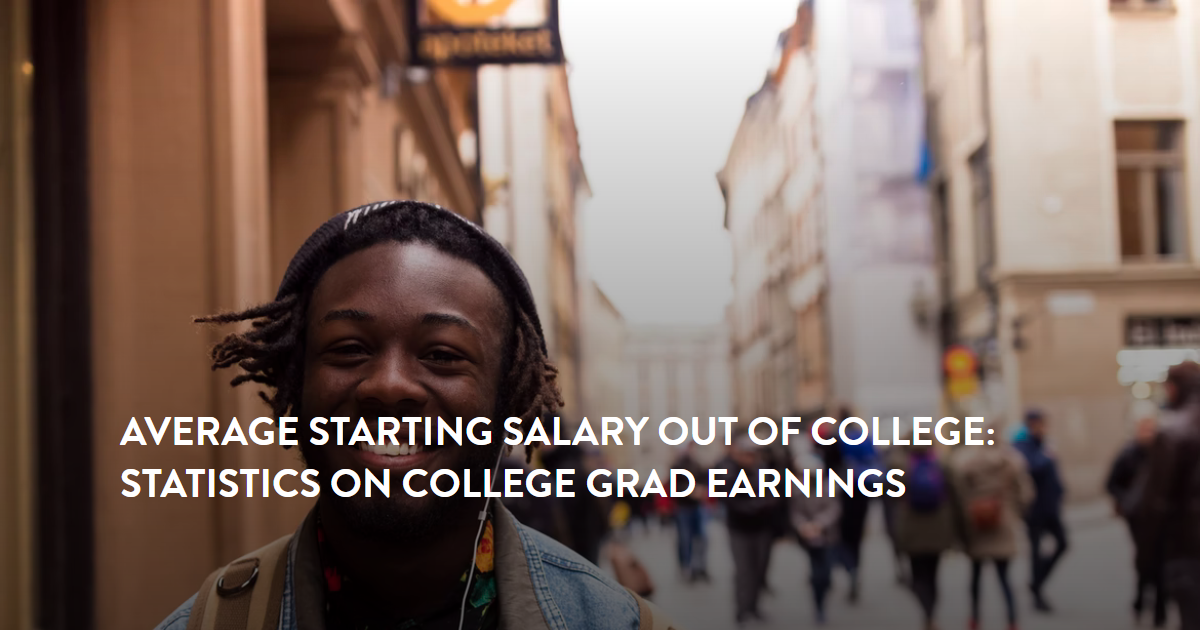- HR Statistics
- Average Labor Cost Percent Of Sales
- Average Time to Reach Profitability At A Startup
- Office Space Per Employee
- Recruitment Statistics
- Employee Engagement Statistics
- Work-Life Balance Statistics
- BYOD Statistics
- Paternity Leave Statistics
- Onboarding Statistics
- Average Paid Maternity Leave In Us
- Average Cost Of A Bad Hire
- Employee Theft Statistics
- Paid Family Leave Statistics
- Cost Of Hiring Statistics
- Employee Turnover Statistics
- Average Cost Of Employer Sponsored Health Insurance Statistics
- Sexual Harassment In The Workplace Statistics
- HR Statistics
- PTO Statistics
- Social Media Recruitment Statistics
- Hiring Statistics
- Out Of Prison Employment Statistics
Paternity leave research summary. Taking paternity leave is slowly growing in popularity, but research shows that the length of paternity leave in the US may still lag behind expectations. The fact is that standard paternity leave in the US lags behind many other countries.
Here are some key statistics on paternity leave in the US:
-
The average paternity leave length is approximately one week in the United States.
-
In comparison, the average paid leave reserved for fathers in the European Union totaled 6.3 weeks.
-
45% of companies offer paid paternity leave.
-
Only 20% of all employees have access to paid family leave, and 11% of workers don’t even have the opportunity for unpaid leave.
-
20% of men felt that the biggest downside of taking paternity leave was the worry that they were risking a setback in their career.
-
76% of fathers will return to work in less than a week after welcoming a new child.
For further analysis, we broke down the data in the following ways:
State | Company | Benefits | Stigma | Trends
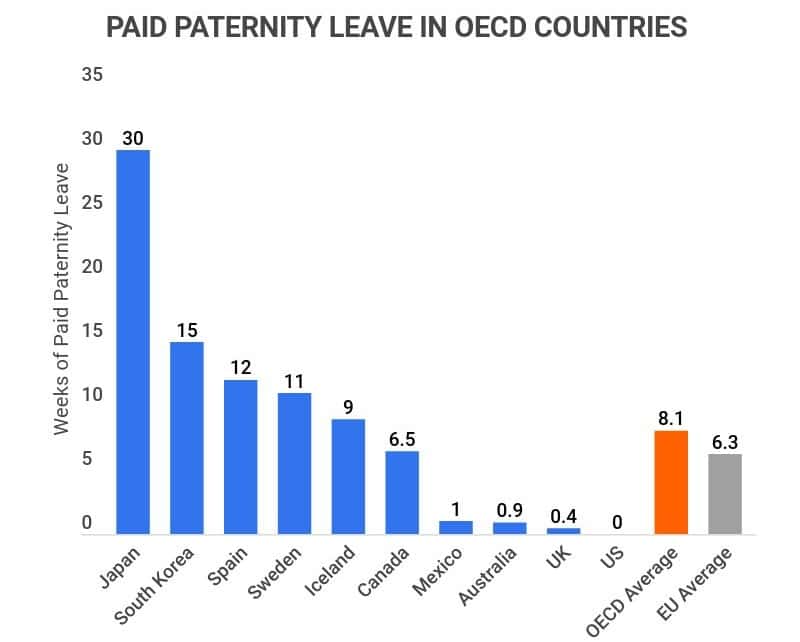
Paid paternity leave length and pay rate in OECD countries
| Country | Weeks of Paid Leave | Pay Rate |
|---|---|---|
| Japan | 30 | 67% |
| South Korea | 15 | 80% (First 12 weeks)50% (12+ weeks) |
| Spain | 12 | 100% |
| Sweden | 11 | 78% |
| Iceland | 9 | 80% |
| Canada | 6 | 55% |
| Mexico | 1 | 60% |
| Australia | 0.9 | National minimum wage |
| UK | 0.4 | $200/week or 90% weekly pay, whichever is lowest |
| US | 0 | 0% |
General paternity leave statistics
Paternity leave has become more important than ever before with the breakdown of gender roles and introduction of marriage equality. More and more parents want to spend valuable time with their new babies, whether they be male or female. Knowing that, we’ve gathered some general facts about paternity leave:
-
91% of fathers who weren’t permitted paid paternity leave said that they would’ve taken more time with their families had it been available in a 2014 survey.
Additionally, nearly all fathers (95%) rated flexibility in the workplace as crucial to maintaining their professional life with their family needs.
-
13% of men who took parental leave in the past two years say it had a negative impact on their career.
In comparison, 25% of women who took parental leave in the past two years stated that it had a negative impact on their careers. On the other hand, 66% of men who took paternity leave and 54% of women who took maternity leave believed that it had no noticeable impact on their careers.
-
89% of fathers agreed that it is important for employers to provide paid paternity leave, in a 2014 survey.
However, five out of six participants in this survey also stated that they would not take paternity leave unless it covered 70% of their salary at minimum.
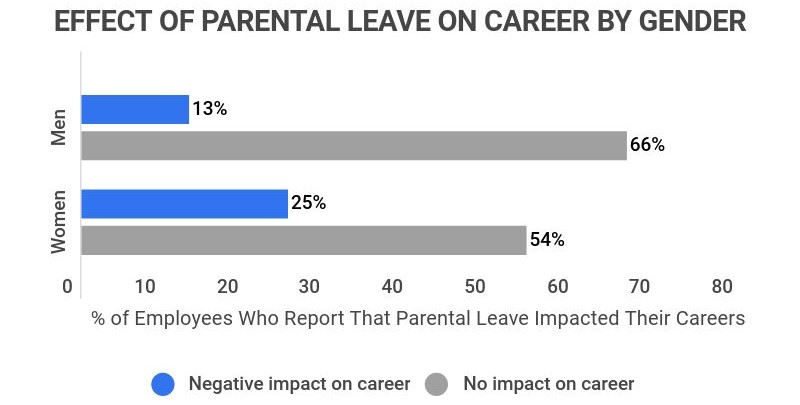
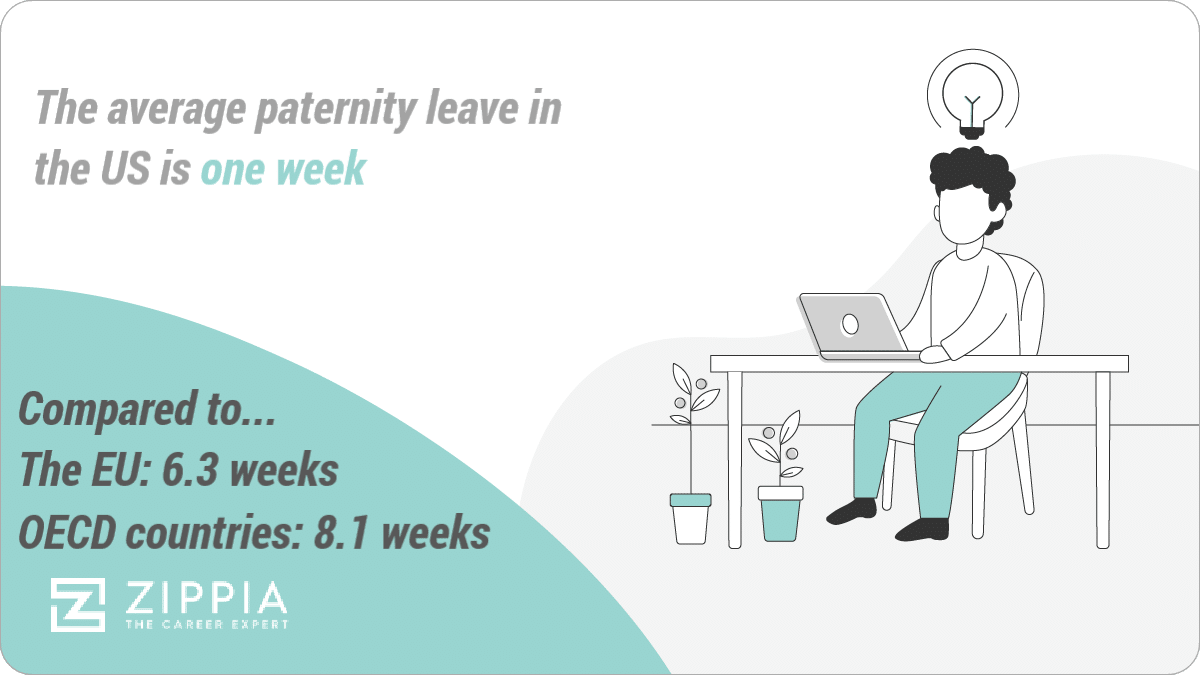
Paternity leave statistics by state
Paternity leave offered can vary greatly based on the state you live in, as there is no federal paternity leave laws. To find out more about paternity laws by state, here are some essential statistics:
-
New York, California, Rhode Island, New Jersey, Washington, and Washington D.C. are the only places in the United States that have laws in place to mandate paid parental leave.
Beyond these states, American fathers are only protected by the Family and Medical Leave Act of 1993, which entitles them to return to their job after situations like the birth or adoption of a new child in the family.
However, the FMLA only accounts for unpaid leave, and only employees who have worked a minimum of 1,250 hours in the year prior to the leave at a company with more than 50 people are eligible to receive it.
This, unfortunately, leaves many new fathers turning down their chance to bond with their children in the first few weeks of their lives because they can’t afford to go without pay during that time.
-
As of 2017, New York offers the most generous paternity leave program.
New York’s program regarding paid paternity leave includes up to ten weeks off for parents following the birth or adoption of their child while receiving up to 60% of their typical wages and job protection during their time away.
-
Companies like Google and Netflix have found that giving parents access to paid time off has positive impacts on employee retention rates.
These major companies have also found that extended paid paternity leave decreases an employee’s need to lean on government assistance after the costly arrival of a new baby.
-
The companies with the most extensive parental paid leave benefits include Alphabet, Microsoft, Procter Gamble, and Amazon.
Amazon’s policy for parental leave includes up to six weeks of paid paternity leave and 20 weeks of paid maternity leave. Procter Gamble offers 8 weeks of paid paternity leave and provides the option for both mothers and fathers to take up to a year off with combined paid and unpaid leave.
Microsoft gives new mothers 20 weeks of paid leave after having a baby and gives all other parental figures involved 12 weeks of paid leave. The parent company of Google, Alphabet, supplies up to 18 weeks of paid leave for all new parents.
-
As of 2018, private sector businesses represent 16% of the companies that offer paid leave for both parents.
It has also been found that receiving parental leave benefits are more common at larger companies.
The Bureau of Labor Statistics indicates that 25% of employees at organizations with more than 500 people have access to paid maternity and paternity leave, compared to 12% at companies with less than 99 employees.
-
One study found that individuals with middle and higher incomes were much more likely to receive paid time off than people with a lower income through either benefits or accrued time off.
75% of people who had an income of $75,000 or higher state that they were offered at least some paid time off when they needed it for family or medical reasons, including parental leave. This starkly contrasts the 37% of people who earn under $30,000 that were provided with paid leave.
Paternity leave statistics by company
Paternity leave in the US is often dependent on the company you work for, as most states don’t guarantee it. If you want to know more about paternity leave offered by companies, here are some insights our research uncovered:
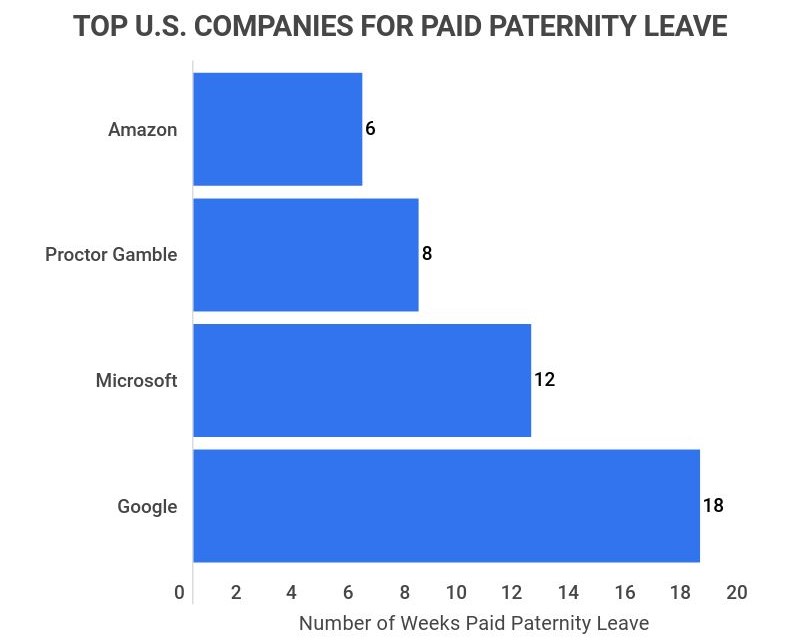
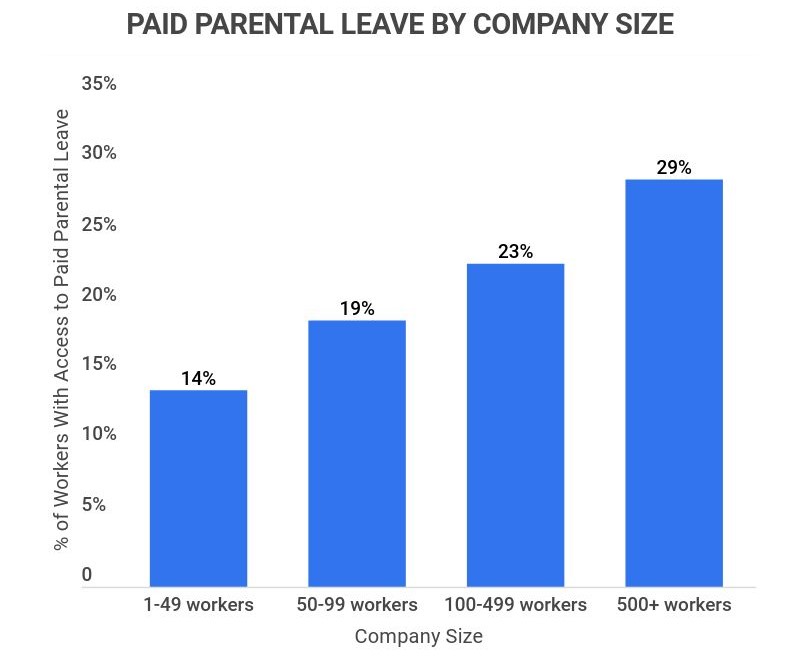
Benefits of paternity leave statistics
Paternity leave offers many benefits for parents. From improving relationships between spousal partners to improving the wage gap, here are some essential benefits:
-
90% of men indicated that taking paternity leave improved their relationship with their spousal partner.
-
40% of the parents who did not receive paternity leave ended up getting divorced within 15 years, suggesting that paternity leave decreases the divorce rate by 9%.
-
It’s been proposed by the National Partnership for Women and Families that paid paternity leave will help to close the gender wage gap by assisting women to remain in the workforce, equalizing caregiving in a two-parent household, and helping women provide for their families.
Paternity leave stigma statistics
Paternity leave often still isn’t accepted culturally, especially for men. This can lead fathers to refuse leave, especially when they feel their financial security is on the line.
-
86% of men stated that they would not use their paternity leave unless provided at least 70% of their salary.
The same study found that 45% of participants stated that they would not take paternity leave unless their employer covered the full 100% of their salary.
-
Approximately 23% of men who have access to paternity leave don’t take it.
A principal at the company who created this report stated a few crucial steps to creating a better approach to parental leave in the professional world.
These steps include having parental leave policies for men, educating leadership within companies about the importance of paternity leave, and creating a culture that supports paternity leave.
-
Men don’t take paternity leave because they don’t want to lose out on a percentage of their salary or miss out on any professional opportunities in their absence.
While there have been big and positive changes in the paternity leave companies offer, fathers still often feel the pressure to return to work much more quickly than mothers.
Even when paid paternity leave is provided, many new fathers think that taking full advantage of this time can strain their family’s financials or professional future. This means that many men are making the difficult choice between bonding with their new child and making money.
Paternity leave trends and projections
Paternity leave has become more popular over time, and though the US still has a long way to go, some states have already started implementing paternity leave laws. For more paternity leave trends and projections, consider these facts:
-
Between 1994 and 2015, the number of fathers taking paternity leave each month rose from 5,798 to 13,083 in the United States.
-
There are 90 countries worldwide that currently offer statuary-paid paternity leave.
-
In 1993, the Family and Medical Leave Act (FMLA) extended up to 12 weeks of unpaid but job-protected leave per year that could be used for certain family and medical situations like the birth or adoption of a child.
-
In California, the California Family Rights Act expansion was enacted in 2021, giving fathers up to 12 weeks in a year to spend bonding with a new child, handling a health condition, or caring for a family member.
Paternity leave FAQ
-
How long is typical paternity leave in the United States?
The typical paternity leave in the United States is approximately one week. The amount of paternity leave that an employee receives depends on several factors, such as the state they live in, their employer, and their position within their company.
-
Does paternity leave include full pay?
Whether a new father receives full pay during their paternity leave depends on the benefits package outlined by the company that they’re employed with. Unfortunately, there isn’t any formal requirement for companies to offer their employees paid time off.
The Family and Medical Leave Act (FMLA) provides up to 12 weeks of job-protected time off for some employees, like new fathers, but this time off is not paid at all.
Often, paid paternity leave does not provide an employee’s full salary. Some employees only receive half of their usual wages. Others earn between 70-90% of their typical compensation. A few will be offered full pay during paternity leave in the United States.
-
Can paternity leave be denied?
No, paternity leave cannot be denied. More specifically, employees eligible for the Family and Medical Leave Act cannot legally be denied their time off for becoming a new parent. This reality was solidified in 2003 when it was ruled that the denial of paternity leave for men is sex discrimination that forces women into a continued cycle of being the primary caregiver for new children.
-
What are the benefits of taking paternity leave?
The biggest benefits of taking paternity leave are that it strengthens a father’s bond with their new child and has been shown to positively impact their spousal relationship.
The first few weeks of a child’s life are crucial for creating a long-lasting parental relationship for a father and child, but it’s also beneficial in alleviating some of the weight put on new mothers.
A professional climate that limits men’s access to paternity leave puts pressure on the mother to constantly be the primary caretaker without a moment’s break. Lacking involvement from a paternal unit can also lead to increased rates of postpartum depression and make the mother’s professional life more difficult.
Taking ample paternity leave to spend time with family can also positively impact a man’s work performance. Many men who have spent a significant amount of time bonding after the arrival of a new child said that their feelings of happiness and fulfillment also extended to their professional life, thereby improving their productivity.
In one survey, 100% of the men who took paternity leave stated that they were glad they accepted it and would do it again if they had another child.
-
What percentage of Americans have paid parental leave?
Approximately 20% of Americans have access to paid parental leave. The most recent research from the National Compensation Survey found that while 89% of workers have access to unpaid family leave via the FMLA, only about 20% of workers have access to paid parental leave.
Paid parental leave is only mandated in some states, like New York and California. Otherwise, it’s up to the company to decide to extend paid leave options to new parents. Many companies have different policies for birth givers and other parents in the household.
-
How much paternity leave are fathers entitled to?
Both men and women are entitled to up to 8 weeks of leave per child. However, that doesn’t mean those 8 weeks would be paid. Hence why most fathers only take one week off.
Conclusion
The global rise in paternity leave has encouraged an array of positive effects for fathers, their families, and their place of employment. Some of the key benefits being that fathers have time to bond during an influential time in their child’s life, it strengthens the spousal relationship, and it seems to inspire a renewed sense of passion in employees.
Access to longer paternity leave has also been shown to decrease the likelihood of depression in new mothers because they can split up parental responsibilities with their partner during a transition period that can often be overwhelming otherwise.
Despite the extremely positive influence that providing paternity leave can have, the United States lags behind on providing this benefit.
While the Family and Medical Leave Act (FMLA) of 1993 has moved the perception of parental leave in the right direction, this legislation isn’t all-inclusive. The FMLA only covers a small portion of people who have worked for companies with over 50 employees for more than 1,250 hours in the year before taking the leave.
On top of that, even qualifying employees are only entitled to unpaid leave through the FMLA, which is simply not an option for the majority of households following the birth or adoption of a new baby.
Beyond the FMLA, individual states make their own rules regarding mandatory parental leave, and most workers are at the mercy of their employers. Even if an employer does offer paid paternity leave, this is usually provided at a reduced rate. In New York, the state with the most comprehensive parental leave laws, only up to 66% of an employee’s salary is covered.
When financials are incredibly important to a growing family, 86% of men state that they would not take paternity leave unless at least 70% of their salary was covered.
Welcoming a new child into the family should be filled with untethered happiness, but the lack of access to paternity leave can hinder this special time. Moving forward, the United States and its companies must catch up to the paternal leave policies of other countries to improve the lives of employees and their families.
References
-
Pew Research. “Key takeaways on Americans’ views of and experiences with family and medical leave” Accessed on September 24, 2021
-
SHRM. “Key takeaways on Americans’ views of and experiences with family and medical leave” Accessed on September 24, 2021
-
Mckinsey Company. “A fresh look at paternity leave: Why the benefits extend beyond the personal” Accessed on September 24, 2021
-
SHRM. “Availability, Use of Paternity Leave Remains Rare in U.S.” Accessed on September 24, 2021
-
The New Dad. “New Fathers in the Workplace Paternity Spending Habits” Accessed on September 24, 2021
-
OECD. “Parental leave systems” Accessed on September 24, 2021
-
Fatherly. “What Are the Laws Around Paternity Leave and Family Leave in the U.S.?” Accessed on September 24, 2021
-
Tulane University Law School. “Paternity Leave in the U.S. Leaves a Lot of Gaps” Accessed on September 24, 2021
-
Insider. “10 of the best companies for new parents, including Amazon, Microsoft, and Freddie Mac” Accessed on September 24, 2021
-
HR Morning. “2020 trends: More employers offering paid parental leave”
-
Oxford University Press Blog. “How paternity leave can help couples stay together” Accessed on September 24, 2021
-
Forbes. “How Paid Paternity Leave Can Help Close The Gender Pay Gap” Accessed on September 24, 2021
-
Pew Research Center. “Americans Widely Support Paid Family and Medical Leave, but Differ Over Specific Policies” Accessed on September 24, 2021
-
National Partnership for Women and Families. “Paid Leave Will Help Close the Gender Wage Gap” Accessed on September 24, 2021
-
SHRM. “To Improve Gender Equality, Help Men Take Parental Leave” Accessed on September 24, 2021
-
NCBI. “Divergent Trends in US Maternity and Paternity Leave, 1994–2015” Accessed on September 24, 2021
-
Hackler Flynn Associates. “Your Guide to Paternity Leave in 2021” Accessed on September 24, 2021
-
U.S. Department of Labor. “Family and Medical Leave (FMLA)” Accessed on September 24, 2021
-
Leigh Law Group. “Can men be fired for taking paternity leave?” Accessed on September 24, 2021
-
Bureau of Labor Statistics. “Employee Benefits in the United States, March 2020” Accessed on September 24, 2021
- HR Statistics
- Average Labor Cost Percent Of Sales
- Average Time to Reach Profitability At A Startup
- Office Space Per Employee
- Recruitment Statistics
- Employee Engagement Statistics
- Work-Life Balance Statistics
- BYOD Statistics
- Paternity Leave Statistics
- Onboarding Statistics
- Average Paid Maternity Leave In Us
- Average Cost Of A Bad Hire
- Employee Theft Statistics
- Paid Family Leave Statistics
- Cost Of Hiring Statistics
- Employee Turnover Statistics
- Average Cost Of Employer Sponsored Health Insurance Statistics
- Sexual Harassment In The Workplace Statistics
- HR Statistics
- PTO Statistics
- Social Media Recruitment Statistics
- Hiring Statistics
- Out Of Prison Employment Statistics





